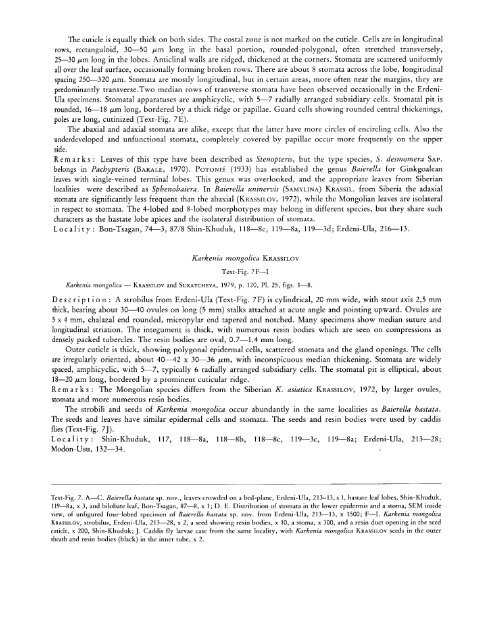EARLY CRETACEOUS FLORA OF MONGOLIA
EARLY CRETACEOUS FLORA OF MONGOLIA
EARLY CRETACEOUS FLORA OF MONGOLIA
You also want an ePaper? Increase the reach of your titles
YUMPU automatically turns print PDFs into web optimized ePapers that Google loves.
The cuticle is equally thick on both sides. The costal zone is not marked on the cuticle. Cells are in longitudinal<br />
rows, rectanguloid, 30—50 ^m long in the basal portion, rounded-polygonal, often stretched transversely,<br />
25—30 /лт long in the lobes. Anticlinal walls are ridged, thickened at the corners. Stomata are scattered uniformly<br />
all over the leaf surface, occasionally forming broken rows. There are about 8 stomata across the lobe, longitudinal<br />
spacing 250—320 /лт. Stomata are mostly longitudinal, but in certain areas, more often near the margins, they are<br />
predominantly trans verse. Two median rows of transverse stomata have been observed occasionally in the Erdeni-<br />
Ula specimens. Stomatal apparatuses are amphicyclic, with 5—7 radially arranged subsidiary cells. Stomatal pit is<br />
rounded, 16—18 /лт long, bordered by a thick ridge or papillae. Guard cells showing rounded central thickenings,<br />
poles are long, cutinized (Text-Fig. 7E).<br />
The' abaxial and adaxial stomata are alike, except that the latter have more circles of encircling cells. Also the<br />
underdeveloped and unfunctional stomata, completely covered by papillae occur more frequently on the upper<br />
side.<br />
Remarks : Leaves of this type have been described as Stenopteris, but the type species, S. desmomera SAP.<br />
belongs in Pachypteris (BARALE, 1970). POTONIE (1933) has established the genus Baierella for Ginkgoalean<br />
leaves with single-veined terminal lobes. This genus was overlooked, and the appropriate leaves from Siberian<br />
localities were described as Sphenobaiera. In Baierella uninervis (SAMYLINA) KRASSIL. from Siberia the adaxial<br />
stomata are significantly less frequent than the abaxial (KRASSILOV, 1972), while the Mongolian leaves are isolateral<br />
in respect to stomata. The 4-lobed and 8-lobed morphotypes may belong in different species, but they share such<br />
characters as the hastate lobe apices and the isolateral distribution of stomata.<br />
Locality: Bon-Tsagan, 74—3, 87/8 Shin-Khuduk, 118—8c, 119—8a, 119—3d; Erdeni-Ula, 216—13.<br />
Karkenia mongolica KRASSILOV<br />
Text-Fig. 7F—I<br />
Karkenia mongolica — KRASSILOV and SUKATCHEVA, 1979, p. 120, PI. 25, figs. 1—8.<br />
Description: A strobilus from Erdeni-Ula (Text-Fig. 7F) is cylindrical, 20 mm wide, with stout axis 2,5 mm<br />
thick, bearing about 30—40 ovules on long (5 mm) stalks attached at acute angle and pointing upward. Ovules are<br />
5x4 mm, chalazal end rounded, micropylar end tapered and notched. Many specimens show median suture and<br />
longitudinal striation. The integument is thick, with numerous resin bodies which are seen on compressions as<br />
densely packed tubercles. The resin bodies are oval, 0.7—1.4 mm long.<br />
Outer cuticle is thick, showing polygonal epidermal cells, scattered stomata and the gland openings. The cells<br />
are irregularly oriented, about 40—42 x 30—36 /лт, with inconspicuous median thickening. Stomata are widely<br />
spaced, amphicyclic, with 5—7, typically 6 radially arranged subsidiary cells. The stomatal pit is elliptical, about<br />
18—20 /лт long, bordered by a prominent cuticular ridge.<br />
Remarks: The Mongolian species differs from the Siberian K. asiatica KRASSILOV, 1972, by larger ovules,<br />
stomata and more numerous resin bodies.<br />
The strobili and seeds of Karkenia mongolica occur abundantly in the same localities as Baierella hastata.<br />
The seeds and leaves have similar epidermal cells and stomata. The seeds and resin bodies were used by caddis<br />
flies (Text-Fig. 7J).<br />
Locality: Shin-Khuduk, 117, 118—8a, 118—8b, 118—8c, 119—3c, 119—8a; Erdeni-Ula, 213—28;<br />
Modon-Usu, 132—34.<br />
Text-Fig. 7. A—C. Baierella hastata sp. nov., leaves crowded on a bed-plane, Erdeni-Ula, 213-13, x 1, hastate leaf lobes, Shin-Khuduk,<br />
119—8 a, x 3, and bilobate leaf, Bon-Tsagan, 87—8, x 1; D. E. Distribution of stomata in the lower epidermis and a stoma, SEM inside<br />
view, of unfigured four-lobed specimen of Baierella hastata sp. nov. from Erdeni-Ula, 213—13, x 1500; F—I. Karkenia mongolica<br />
KRASSILOV, strobilus, Erdeni-Ula, 213—28, x 2, a seed showing resin bodies, x 10, a stoma, x 300, and a resin duct opening in the seed<br />
cuticle, x 200, Shin-Khuduk; J. Caddis fly larvae case from the same locality, with Karkenia mongolica KRASSILOV seeds in the outer<br />
sheath and resin bodies (black) in the inner tube, x 2.

















